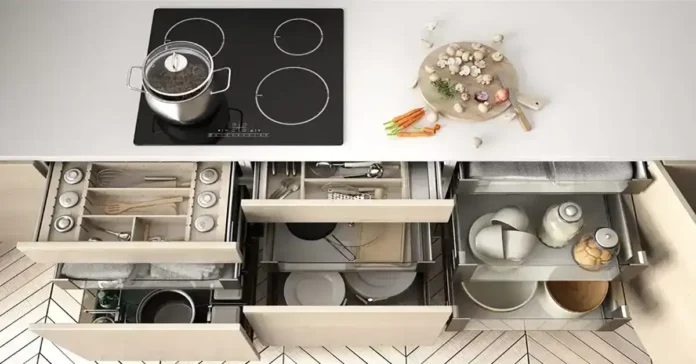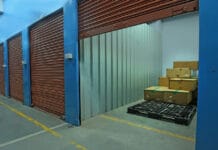Are you tired of rummaging through cluttered cabinets and drawers in your kitchen? It’s time for a transformation! With our creative kitchen organization ideas, you can maximize your space and create a more efficient, functional kitchen. Whether you’re embarking on a full-scale renovation or just looking to declutter, these tips will help you make the most of every inch of your kitchen.
From clever home storage solutions to smart utility storage ideas, we’ll guide you through practical ways to streamline your kitchen. Discover how to utilize vertical space, implement drawer organizers, and create designated zones for all your cooking essentials. With these ideas, you can turn your kitchen into a well-organized haven that makes cooking and cleaning a breeze. Say goodbye to chaos and hello to a beautifully organized space! Let’s dive into these innovative solutions and transform your kitchen today.
Kitchen Organization Ideas
Our guide will help you tackle everyday kitchen challenges by providing tips for storage solutions, drawers, and counters.
1. Inventory Your Kitchen Supplies
Starting with a comprehensive inventory of your kitchen supplies is the first step to effective organization. Make a detailed list of everything you store in your kitchen, including cookware, utensils, appliances, pantry items, and even cleaning supplies. This inventory helps you understand the scope of your task and prioritize which areas need the most attention. Knowing exactly what you have allows you to plan better and avoid unnecessary purchases.
As you list items, note their condition and frequency of use. This process not only helps in organizing but also in decluttering, as you may find things you no longer need or use. An organized inventory acts as a foundation for all your kitchen organization efforts, ensuring you have a clear understanding of what needs to be stored and where.
2. Categorize Your Kitchen Items
Once you have an inventory, the next step is categorizing your kitchen items. Group similar items together based on their usage and frequency. For example, place all baking supplies in one category, cooking utensils in another, and dining ware in a separate group. This categorization helps you determine the amount of storage space needed for each type of item.
Write down the quantities of glasses, plates, mugs, and appliances to assess your storage requirements accurately. By organizing items into categories, you can create dedicated storage zones, making it easier to find what you need when you need it. This method also helps in keeping your kitchen tidy and prevents overcrowding of storage spaces.
3. Kitchen Organization Ideas – Discard Expired Foods
A key aspect of kitchen organization is regularly discarding expired foods and old spices. Set a monthly schedule to clean out your fridge, pantry, and spice cupboard. Check expiration dates and toss anything that is no longer fresh or usable. This practice not only keeps your kitchen clean but also ensures that you are using fresh ingredients in your cooking.
Additionally, removing items you no longer need or haven’t used in a while helps declutter your storage spaces. Regularly cleaning and organizing your food storage areas prevents the accumulation of unnecessary items and makes room for new supplies. It also helps in maintaining a hygienic kitchen environment.
4. Store Essentials Within Easy Reach
For a well-organized kitchen, store your most frequently used items within easy reach. Staples like flour, rice, spices, and frequently used cookware should be stored in easily accessible locations. Lower shelves are ideal for these items, as they are within your line of sight and easy to reach. This setup saves time and effort during meal preparation and cooking.
By keeping your essentials front and center, you minimize the need to rummage through cabinets and drawers, making your kitchen more efficient. Additionally, having a designated spot for frequently used items helps maintain order and reduces clutter, making your kitchen a more pleasant space to work in.
5. Elevate Special Occasion Items
Special occasion items like porcelain servers, crystal bowls, and fancy dinnerware often take up valuable space in your kitchen. Store these items on higher shelves or in less accessible areas to keep them safe and dust-free. This approach frees up prime storage space for everyday essentials. By keeping special occasion items out of the way, you create a more organized and functional kitchen environment. When you do need these items for special events, they will be easy to find and in perfect condition.
6. Donate or Store Unused Cooking Equipment
Unused cooking equipment can quickly clutter your kitchen. If you have items that you no longer use, consider donating them to someone who can make better use of them. For instance, if you have moved past your homemade pasta-making phase, donate the pasta roller to a new home chef or a small café. If certain items hold sentimental value but are not in regular use, store them in a self-storage facility.
This way, you can keep your kitchen organized without getting rid of items that are important to you. Decluttering your kitchen by removing unused equipment creates more space for the things you use regularly and makes your kitchen more efficient.
7. Use Clear Containers for Dry Goods
Clear containers are an excellent solution for organizing dry goods in your kitchen. Store items like flour, sugar, rice, pasta, and other pantry staples in clear, plastic containers. This not only keeps your pantry neat but also allows you to see the contents at a glance, making it easier to find what you need. Label each container with the contents and expiration dates using stickers, dry-erase markers, or permanent markers.
Clear containers help maintain a clutter-free pantry and prevent food items from going stale or being forgotten. This method of organization also adds a visually appealing element to your kitchen storage.
8. Invest in a Mobile Kitchen Cart
For kitchens with limited space, a mobile kitchen cart can be a game-changer. These carts provide additional storage for small appliances, utensils, cookbooks, and other kitchen essentials. The mobility of the cart allows you to move it around as needed, making it a versatile addition to your kitchen. Use the cart to store items that you frequently use but don’t have a dedicated space for.
When not in use, the cart can be tucked away in a corner. This not only maximizes your kitchen space but also keeps your countertops and cabinets uncluttered. A mobile kitchen cart is a practical and stylish solution for enhancing your kitchen organization.
9. Kitchen Organization Ideas – Install a Pot Rack
Installing a pot rack is a practical way to organize your pots and pans. Instead of stacking them in cabinets where they can be difficult to access and prone to damage, a pot rack keeps them organized and within easy reach. This solution also frees up cabinet space for other items. Pot racks come in various styles and sizes, allowing you to choose one that fits your kitchen’s design and layout.
By hanging your pots and pans, you not only save space but also create a visually appealing focal point in your kitchen. A pot rack is both functional and decorative, making it a smart choice for kitchen organization.
10. Use a Mug Holder
A mug holder is an effective way to organize your mugs and save cabinet space. Whether you have a small collection or a large assortment, a mug holder keeps them neatly arranged and easily accessible. This is especially useful for families where multiple members use mugs frequently. Instead of repeatedly opening and closing cabinets to find a mug, a mug holder allows you to grab one quickly.
Mug holders can be mounted on the wall or placed on the countertop, depending on your preference and kitchen layout. This simple solution not only organizes your mugs but also adds a charming touch to your kitchen decor.
11. Store Knives Safely
Proper knife storage is crucial for kitchen safety and organization. Loose knives in drawers can be dangerous and can also become dull more quickly. Using a knife block or a dedicated drawer insert for knives keeps them safely stored, easily accessible, and sharp. A knife block on the countertop or a magnetic strip on the wall are also great options for organizing your knives.
This not only ensures safety but also keeps your knives in good condition. Safe and organized knife storage makes your kitchen more efficient and reduces the risk of accidents.
12. Get a Cutting Board That Fits Over Your Sink
A cutting board that fits over your sink is a smart space-saving solution for small kitchens. This type of cutting board utilizes the often unused space over your sink, providing you with additional counter space for food preparation. Some cutting boards even come with built-in colanders, making it easy to rinse and chop vegetables in one place.
This multifunctional tool keeps your kitchen organized by consolidating tasks and reducing the need for extra counter space. It also helps keep your cutting board clean and tidy, as food scraps can be easily disposed of directly into the sink.
13. Leverage Spice Racks
Spice racks are essential for keeping your herbs and spices organized and within easy reach. Whether you opt for a wall-mounted rack, a drawer insert, or a rotating countertop rack, spice racks help you store spices in an orderly manner. Labeling each spice jar makes it easy to find what you need, speeding up meal preparation.
By organizing your spices, you also avoid buying duplicates and ensure that your spices stay fresh longer. Spice racks not only enhance the functionality of your kitchen but also add a touch of style to your culinary space.
14. Tension Rod Storage Hack
Tension rods are versatile tools for kitchen organization. They can be used to create additional storage space without the need for nails or screws, making them ideal for rental properties. Place tension rods under the sink to hang cleaning supplies or across cabinets to store cutting boards and baking sheets vertically.
You can also use them inside cabinets to create dividers for lids and trays. This simple and inexpensive hack helps maximize storage space and keeps your kitchen tidy. Tension rods are easy to install and adjust, making them a flexible solution for various organizational needs.
15. Kitchen Organization Ideas – Use Wall Space
Maximizing wall space is key to effective kitchen organization. Install pegboards, hooks, and shelves to utilize vertical space for storing pots, pans, utensils, and other kitchen tools. Hanging items on the wall keeps your countertops clear and your kitchen more organized. Pegboards are especially useful as they can be customized with different hooks and shelves to fit your needs.
This approach not only saves space but also makes your kitchen items more accessible. Using wall space creatively can transform your kitchen into a functional and aesthetically pleasing area, making cooking and cleaning more enjoyable.
Final Words on Kitchen Organization Ideas
Implementing these creative kitchen organization ideas will transform your space into a more efficient and enjoyable environment. By inventorying your supplies, categorizing items, and utilizing smart storage solutions, you can maximize your kitchen’s potential. Regularly discarding expired foods, donating unused equipment, and using clear containers and mobile carts help maintain order and cleanliness.
Embrace innovative storage hacks like pot racks, mug holders, and tension rods to keep everything in its place. Leveraging vertical and wall space ensures that your kitchen remains clutter-free and accessible. With these tips, you’ll create a well-organized kitchen that simplifies your cooking routine and enhances the overall functionality of your home.
FAQs for Kitchen Organization Ideas
A: Start by decluttering your kitchen, removing items you no longer need. Utilize drawer dividers, shelf organizers, and clear storage containers to keep everything tidy.
A: Use vertical space by adding shelves or hanging racks. Install hooks for pots and pans, and consider using multi-functional furniture like kitchen islands with storage underneath.
A: Group similar items together, such as spices, baking supplies, and canned goods. Use baskets or bins to keep smaller items organized and label everything.
A: Store frequently used items within reach but off the counter, such as in pull-out drawers or wall-mounted racks.
A: Use clear containers to store dry goods. Arrange items by category and frequency of use, and place heavier items on lower shelves for safety.
A: Use drawer dividers to separate utensils, cutlery, and other small items. Consider using inserts for knives and other tools to keep them arranged.
A: Group similar items together, such as dairy, fruits, and vegetables. Use clear bins to separate items and label shelves to ensure everything has a designated spot.
A: Arrange your kitchen based on the workflow, keeping cooking utensils near the stove and prep tools close to the countertops.
A: Use stackable bins or pull-out organizers to maximize the vertical space. Keep cleaning supplies in one area and tools like sponges and brushes in another to maintain order.
A: Regularly declutter and assess what you use most often. Create habits like putting things back in their designated spots immediately after use every day.








